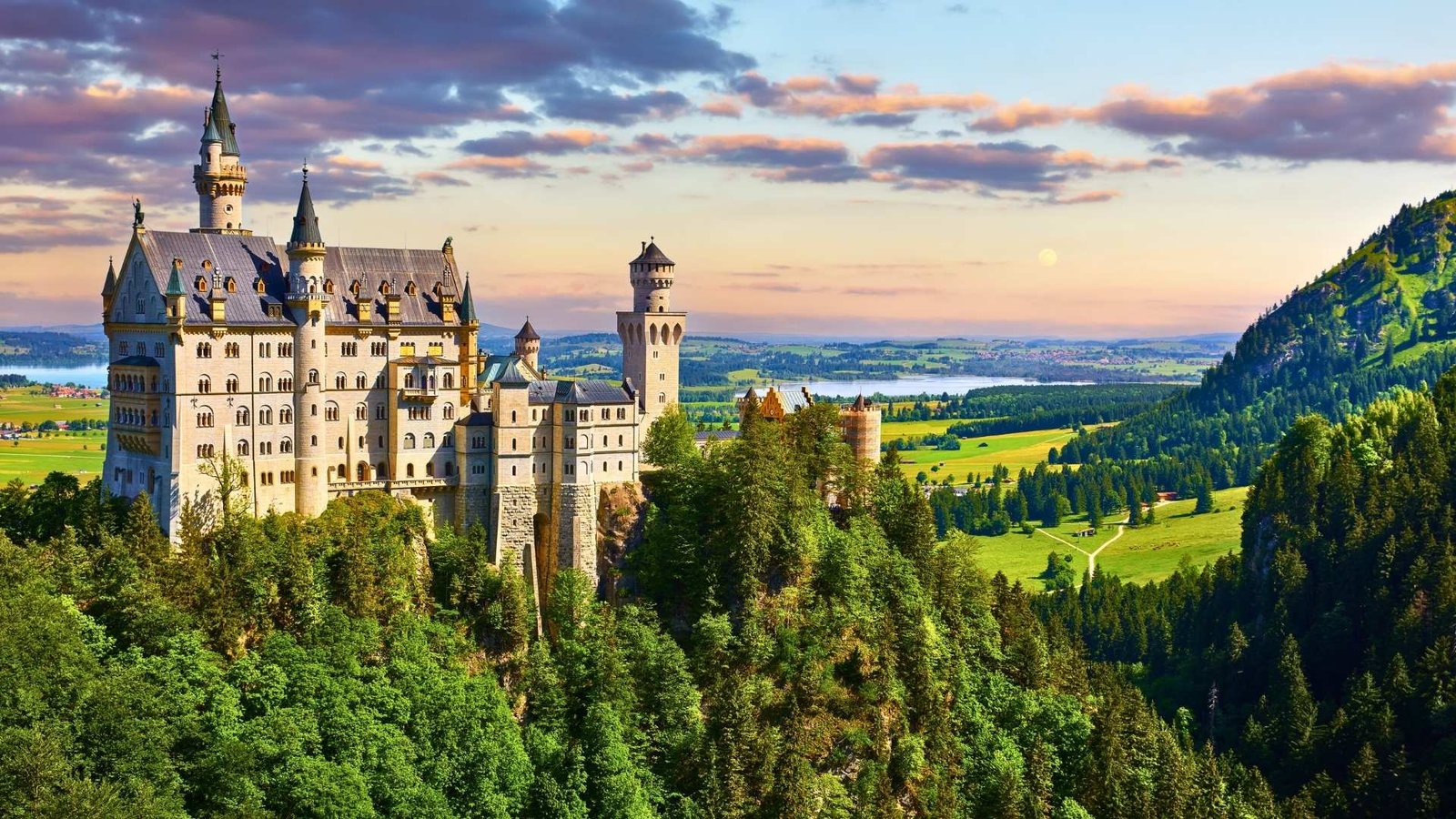The Beautiful Castles of Europe
Europe is practically drowning in castles. From grand palaces fit for royalty to eerie fortresses straight out of Gothic novels, the continent is a treasure trove of stone walls, hidden passageways, and histories steeped in drama. Some are straight-up Disney material, while others look like they belong in a vampire movie. Here are twelve of the most famous, each with its own peculiar charm.
Neuschwanstein Castle in Germany is the ultimate fairytale fortress, a vision straight out of a storybook. Perched dramatically on a rugged hill in Bavaria, this 19th-century masterpiece was the brainchild of King Ludwig II, the so-called “Mad King” who was far more interested in creating dreamlike architectural fantasies than in ruling his kingdom. Designed as an homage to medieval chivalry and the operatic works of Richard Wagner, the castle is a blend of Romanesque Revival architecture, intricate frescoes, and breathtaking mountain views. Its whimsical turrets and idyllic setting famously inspired Disney’s Sleeping Beauty Castle, making it one of the most recognisable landmarks in the world.
Ludwig’s obsession with creating a perfect fantasy world came at a high cost. The castle’s construction, which began in 1869, took far longer than planned and drained the royal treasury. By the time of Ludwig’s mysterious death in 1886—found drowned in a lake under circumstances that remain the subject of endless speculation—Neuschwanstein was still incomplete. Some believe he was murdered, others say he took his own life after being declared insane and deposed from the throne. Ironically, the castle he built for solitude and artistic escape was opened to the public just weeks after his death and has since become one of the most visited sites in Germany.
Despite its fairy-tale appearance, Neuschwanstein was ahead of its time in engineering. The castle featured running water, central heating, and even an early version of a telephone system—luxuries unheard of in many homes of the era. Every detail, from the hand-carved woodwork to the vibrant murals depicting Wagnerian operas, reflects Ludwig’s vision of a world untouched by politics or practicality. Today, it welcomes over a million visitors each year, standing as both a tribute to an eccentric king’s dream and a monument to the blurred lines between fantasy and reality.

Looming over Scotland’s capital like a medieval bodyguard, Edinburgh Castle is an unmissable icon of the city’s skyline, steeped in bloodshed, royal intrigue, and some of the most dramatic history in Britain. Built on an extinct volcanic rock, this formidable fortress has witnessed more battles, sieges, and betrayals than a season of Game of Thrones. With its commanding position over Edinburgh, the castle was both a defensive stronghold and a symbol of royal power, a place where kings were crowned, imprisoned, and occasionally murdered.
The castle’s history stretches back over a thousand years, with evidence suggesting it was a royal residence as early as the 11th century. It became a crucial stronghold during the Wars of Scottish Independence, changing hands multiple times between the Scots and the English. Robert the Bruce famously ordered it to be destroyed in 1314 to prevent it from falling into English hands again, though the fortress was later rebuilt. Mary, Queen of Scots gave birth to her only son, James VI, within these walls, and centuries later, Jacobite forces tried—and failed—to retake it.
One of its most famous treasures is the Stone of Destiny, a sacred object used in the coronation of Scottish and later British monarchs. The English took it in 1296, placing it in Westminster Abbey, where it remained for centuries until a group of Scottish students dramatically stole it back in 1950. It was eventually returned to Scotland in 1996, where it now resides in the castle’s Crown Room alongside the Scottish Crown Jewels.
For those who love a bit of military precision, the castle fires the famous One O’Clock Gun every day except Sundays, a tradition dating back to 1861. Originally, the gun was a time signal for ships in the Firth of Forth, but now it serves as a quirky reminder of Edinburgh’s traditions—and a great way to startle unsuspecting tourists.
Beyond its military and royal significance, the castle is also home to chilling legends. Visitors speak of ghostly figures haunting the dungeons, including the infamous piper who allegedly vanished within the castle’s underground passages centuries ago. Whether you come for the history, the views, or the ghosts, Edinburgh Castle remains one of the most captivating fortresses in Europe, standing as a proud reminder of Scotland’s turbulent and glorious past.
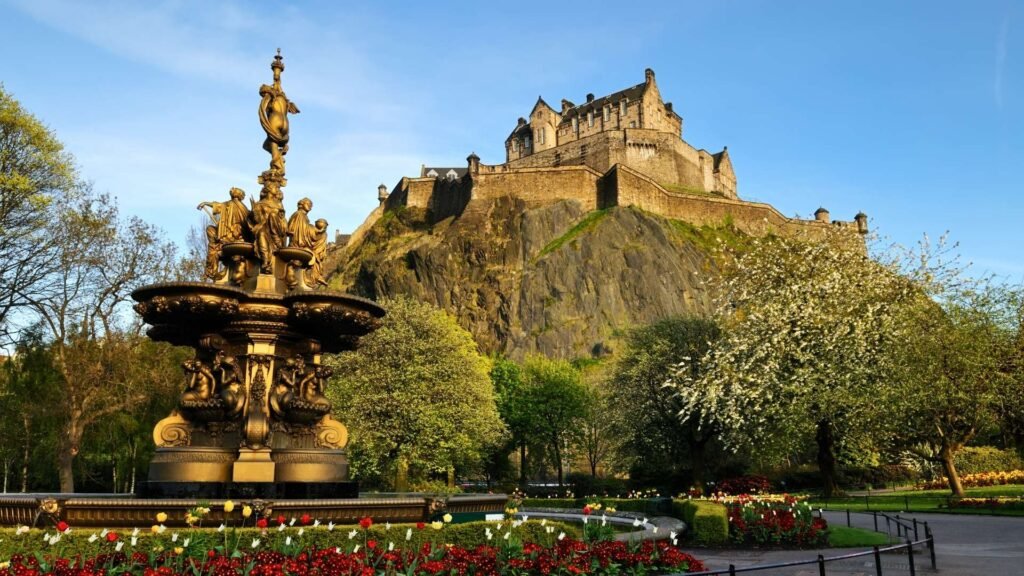
Windsor Castle in England is the world’s largest and oldest occupied castle, an enduring symbol of the British monarchy for nearly a thousand years. Originally built by William the Conqueror in the 11th century as part of his campaign to secure England, it has grown from a wooden motte-and-bailey structure into the grand fortress-palace that stands today. Over the centuries, it has been a residence, a military stronghold, and the backdrop for some of the most pivotal moments in British history.
The castle has played host to a remarkable succession of monarchs, each leaving their mark on its architecture and legacy. Henry VIII, notorious for his turbulent personal life, used Windsor as a retreat for hunting and political plotting. Queen Victoria modernised it, making it her preferred residence after the death of Prince Albert, turning it into a symbol of the British Empire at its peak. More recently, Queen Elizabeth II made Windsor Castle her sanctuary, particularly during the later years of her reign, spending much of her time within its historic walls.
Beyond its royal inhabitants, Windsor has witnessed significant historical events, including the English Civil War, during which it was used as a parliamentary garrison. It also endured the devastating fire of 1992, which ravaged parts of the State Apartments. The fire took 15 hours to control, destroying priceless artworks and interiors. The extensive restoration that followed was a national project, completed with remarkable accuracy and funded in part by opening Buckingham Palace to the public.
The castle is also home to St George’s Chapel, one of the finest examples of Gothic architecture in England and the burial site of numerous monarchs, including Henry VIII and Charles I. More recently, it was the site of high-profile royal weddings, including those of Prince Harry and Meghan Markle, as well as Princess Eugenie.
A visit to Windsor Castle today offers a glimpse into royal life, from the lavish State Apartments adorned with priceless art and chandeliers to the grand Long Walk, where monarchs once rode on horseback. Every stone, every hall, and every hidden passage tells a tale of power, survival, and tradition, making it a living, breathing monument to Britain’s past and present.
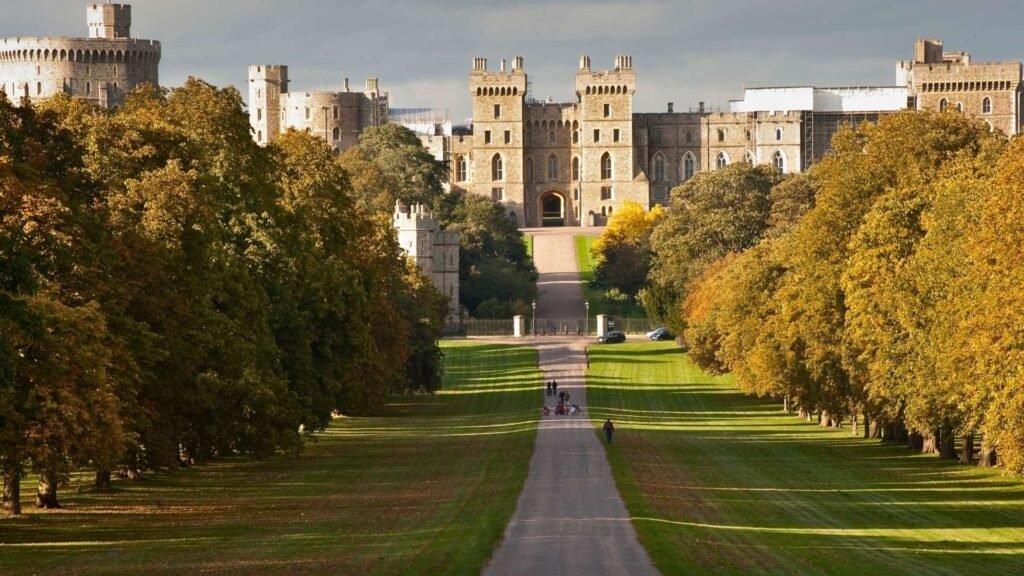
Bran Castle in Romania is often linked to Vlad the Impaler, the ruthless Wallachian ruler whose bloody reputation inspired Bram Stoker’s Dracula. Perched on a rocky cliff in Transylvania, the castle’s eerie, misty silhouette is so perfect for vampire lore that its historical accuracy becomes almost irrelevant. Truth be told, there’s no solid evidence that Vlad ever lived here, though he may have passed through or even been briefly imprisoned within its walls. That minor detail, however, does nothing to stop the endless flow of tourists hoping for a taste of Gothic horror. Romania, fully embracing the legend, has leaned into the vampire tourism, selling everything from Dracula-themed souvenirs to eerie nighttime tours.
The castle itself dates back to the 14th century, originally built as a strategic military fortress to guard the mountain pass between Transylvania and Wallachia. It was later transformed into a royal residence, most notably belonging to Queen Marie of Romania in the early 20th century. She redecorated it in a more romantic, Neo-Gothic style, turning it into a picturesque retreat rather than a grim medieval stronghold. The interiors today still bear traces of her influence, with richly carved wooden furniture, medieval tapestries, and a more lived-in warmth than the foreboding exterior suggests.
Despite its pop-culture reputation as Dracula’s Castle, Bran Castle’s real history is equally fascinating. It has survived sieges, political turmoil, and even a brief stint as a Communist-run museum after Romania’s monarchy was abolished. Now, it functions as both a historical landmark and a haven for all things vampire-related, drawing visitors who come to explore its twisting corridors and hidden staircases, imagining themselves in a world of gothic horror. Whether you’re here for the history or the supernatural intrigue, Bran Castle remains one of Europe’s most captivating and enigmatic fortresses.
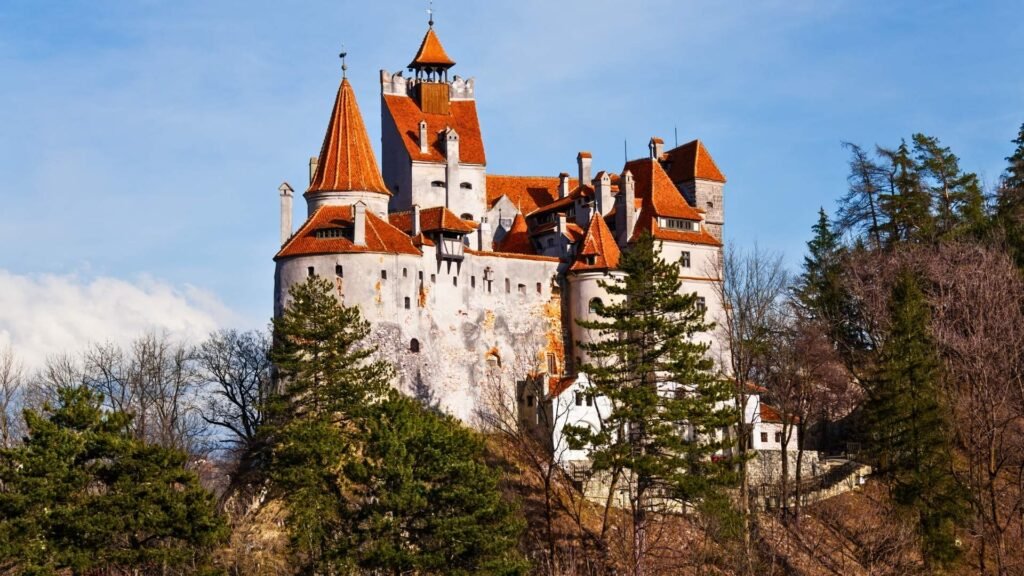
Mont Saint-Michel in France is one of the most spectacular and enigmatic landmarks in Europe. Rising majestically from the tides of the Normandy coast, this medieval fortress-turned-abbey-turned-tourist marvel seems almost otherworldly. During high tide, it appears as if floating on the sea, an ethereal mirage of spires and stone. At low tide, it reveals vast mudflats and treacherous quicksand, trapping the unwary and protecting its secrets.
Originally founded in 708 AD, the island’s religious significance dates back to a reported vision of the Archangel Michael appearing to Bishop Aubert of Avranches, instructing him to build a sanctuary on the rock. As the centuries passed, the site evolved from a humble oratory into an imposing Benedictine abbey by the 10th century. The monks who lived there devoted themselves to both faith and the study of knowledge, creating one of the great monastic centres of medieval Europe. Pilgrims flocked to Mont Saint-Michel, enduring perilous crossings to seek blessings from the holy relics and gaze upon the abbey’s intricate Gothic interiors.
The island’s position made it a natural fortress, and during the Hundred Years’ War, it withstood repeated English sieges, becoming one of the only places in Normandy that the invaders could never conquer. With its towering walls, strategic elevation, and narrow access routes, it was practically impenetrable. Over time, however, its religious purpose declined, and by the late 18th century, Mont Saint-Michel was converted into a prison under the reign of Louis XI. Revolutionary France expanded this use, imprisoning thousands of political dissidents within its formidable walls, earning it the nickname “The Bastille of the Sea.”
Restoration efforts in the 19th century returned Mont Saint-Michel to its former glory, and it was designated a UNESCO World Heritage Site in 1979. Today, it remains a magnet for history lovers, pilgrims, and tourists alike. The medieval village at its base, with its winding cobbled streets and quaint shops, gives visitors a glimpse into what life might have been like in its heyday. Climbing up to the abbey offers breathtaking views over the bay, a setting that changes with the shifting tides and the moody Normandy skies.
One of the most surreal experiences is watching the tide rush back in. The surrounding waters move at astonishing speed, described by Victor Hugo as coming in “as fast as a galloping horse.” For the unprepared, it can be a dangerous spectacle, with stories of unwary visitors getting stranded or misjudging the treacherous quicksand.
Mont Saint-Michel is more than just a castle or an abbey; it is a place steeped in legend, resilience, and awe-inspiring beauty. Whether one arrives seeking history, divine inspiration, or simply a breathtaking view, it offers an experience that is as timeless as the tides that surround it.

Prague Castle in the Czech Republic is more than just a castle—it’s a sprawling architectural masterpiece, the largest ancient castle complex in the world, and a site of immense historical, political, and cultural significance. Covering an area of almost 70,000 square meters, it dominates the skyline of Prague and has been the seat of Czech rulers for over a thousand years. Unlike the fairytale fortresses of Bavaria or the medieval strongholds of Scotland, Prague Castle is an evolving tapestry of Gothic, Romanesque, Baroque, and Renaissance styles, reflecting the dynasties and eras that shaped it.
Founded in the 9th century by Prince Bořivoj of the Přemyslid dynasty, the castle has been a centre of power ever since, serving as the residence of Bohemian kings, Holy Roman Emperors, and later, the presidents of Czechoslovakia and the modern Czech Republic. Its most famous structure, St. Vitus Cathedral, took nearly 600 years to complete and houses the tombs of Czech kings and saints, including Wenceslas I, the ‘Good King Wenceslas’ of Christmas carol fame. The cathedral’s stunning stained-glass windows, intricate stone carvings, and soaring spires make it one of the finest Gothic buildings in Europe.
Prague Castle has also been home to the Bohemian Crown Jewels, which, according to legend, will curse any unworthy person who dares to wear them. The jewels are kept locked away behind seven keys, held by different high-ranking officials, and are only displayed on rare occasions, adding to their mythical allure. The castle has seen its fair share of intrigue, including the famous Defenestration of Prague in 1618, when Protestant nobles threw Catholic officials out of a window, sparking the Thirty Years’ War.
The castle complex also includes the Old Royal Palace, the Basilica of St. George, the picturesque Golden Lane (once home to alchemists, artisans, and even, allegedly, Franz Kafka), and the imposing Powder Tower. Over the centuries, it has survived fires, wars, and sieges, withstanding the ravages of time in a way that few other European castles have managed.
Today, Prague Castle serves as the official residence of the Czech president, a somewhat mundane role considering its dramatic history. However, its courtyards, halls, and ancient alleyways still transport visitors back in time, offering a glimpse into the grandeur and turmoil that shaped Central Europe. Whether you come for the breathtaking views over the city, the legends of cursed crowns, or the sheer weight of history, Prague Castle remains one of the most remarkable and enduring landmarks in Europe.
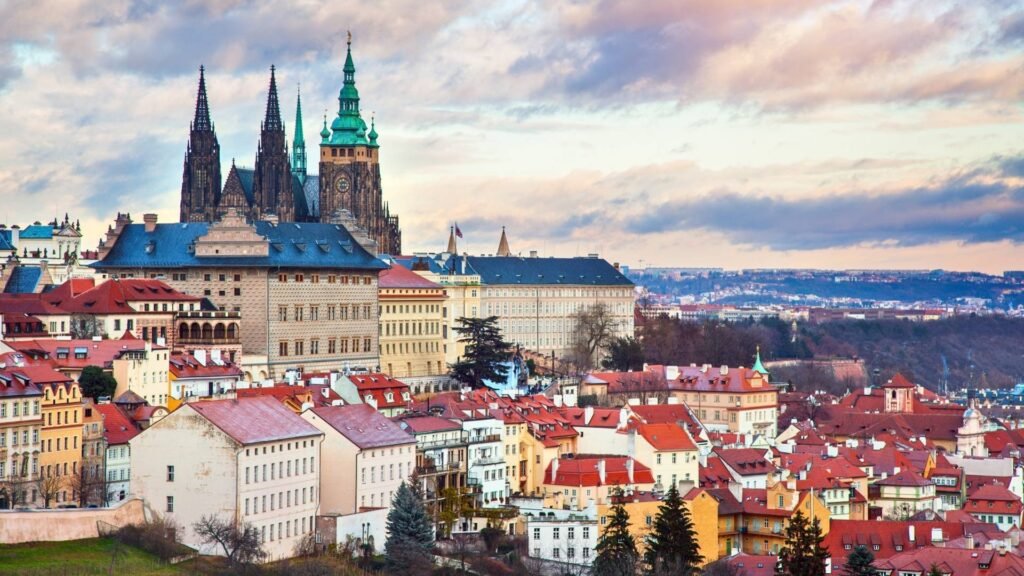
A Moorish masterpiece in Granada, the Alhambra is a stunning fusion of palace, fortress, and paradise garden that encapsulates the height of Islamic architectural brilliance in medieval Spain. Built by the Nasrid rulers in the 13th century, it was conceived as a royal residence and a symbol of the dynasty’s power, offering breathtaking views over the city and the rolling Andalusian hills beyond.
The Alhambra’s construction began in earnest under Muhammad I of Granada in the mid-1200s, and it continued to evolve for over a century, with successive rulers adding new palaces, courtyards, and intricate decorative elements. Unlike the imposing medieval castles of Europe, designed primarily for defense, the Alhambra was a vision of harmony and refinement, blending geometric precision, delicate arabesques, and poetic inscriptions carved into stucco walls. It was not just a place to live but an embodiment of Islamic paradise—lush gardens, cooling fountains, and serene courtyards filled the complex, offering respite from the sweltering Andalusian heat.
The most famous section of the Alhambra is the Palacios Nazaríes, an interconnected series of palaces featuring some of the most intricate craftsmanship in Islamic art. The Court of the Lions, with its 12 marble lion fountains supporting an elaborate basin, is perhaps the most iconic image of the Alhambra. This courtyard was designed not just for beauty but also for innovation, as the fountain’s hydraulic system was an advanced feat of engineering for its time. The Hall of the Ambassadors, used for diplomatic meetings, features a massive domed ceiling with intricate wooden inlays, designed to represent the celestial heavens and to remind visitors of the power and divinely sanctioned rule of the sultans.
Following the Christian Reconquista of Granada in 1492, the Alhambra underwent significant changes. Ferdinand and Isabella, the Catholic Monarchs, took possession of the palace and made modifications to fit their own aesthetic preferences, converting parts of the complex into Christian chapels and adding Renaissance-style buildings, including the Palace of Charles V, a stark contrast to the surrounding Islamic design. While much of the original Moorish splendour remained intact, later centuries saw neglect, with some areas repurposed as barracks and others falling into disrepair.
The Alhambra also bears scars of war and destruction. During the Napoleonic invasion of Spain, French forces occupied the palace-fortress and, upon their retreat in 1812, attempted to destroy it by planting explosives. Fortunately, their efforts failed, leaving much of the structure intact.
Today, the Alhambra is one of Spain’s most visited landmarks, a UNESCO World Heritage Site that attracts millions of tourists each year. Visitors wander through its echoing halls, tracing the Arabic inscriptions that still adorn the walls—verses of poetry, philosophical musings, and tributes to the sultans who once ruled here. It remains a breathtaking testament to the golden age of Al-Andalus, where art, science, and philosophy flourished under Islamic rule. Even Napoleon, who tried to erase it, had to admit that the Alhambra was simply too beautiful to destroy.
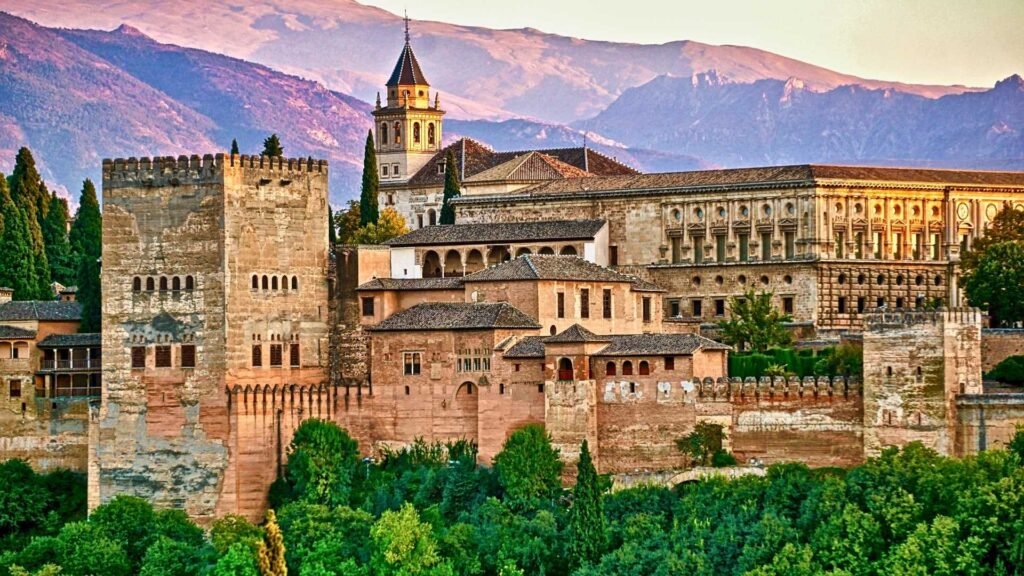
France does castles like nobody else, and Chambord, one of the most unusual castles of Europe, is the ultimate example of aristocratic extravagance. Nestled in the lush Loire Valley, this breathtaking château, commissioned by King Francis I in 1519, is a marvel of Renaissance architecture and royal ambition. Originally conceived as a grand hunting lodge, it quickly evolved into one of the most spectacular châteaux ever built, boasting over 400 rooms, 80 staircases, and an astounding 365 fireplaces—one for every day of the year.
The architectural genius behind Chambord remains a subject of debate, but many attribute its most famous feature—the intricate double-helix staircase—to none other than Leonardo da Vinci. The staircase consists of two intertwined spirals, allowing people to ascend and descend without ever crossing paths, a feat of engineering that reflects da Vinci’s mastery of perspective and movement. This design alone sets Chambord apart, creating a unique sense of space and fluidity that was centuries ahead of its time.
The château’s construction, spanning nearly three decades, required monumental resources. Over 1,800 workers laboured to bring Francis I’s vision to life, using more than 220,000 tons of limestone. Despite its grandeur, Chambord was never intended as a permanent royal residence—Francis I only stayed there for a total of about 50 days during his reign, preferring to use it as a lavish retreat for hosting hunting parties and diplomatic gatherings. The enormous rooms, high ceilings, and vast corridors made it an architectural wonder but an impractical home, lacking proper heating and everyday comforts.
Chambord’s history is as rich as its design. After Francis I’s death, the château was largely neglected until King Louis XIV briefly revived it in the 17th century, using it for court festivities and theatrical performances. Later, it was occupied by exiled Polish King Stanisław Leszczyński before falling into further decline. During the French Revolution, much of its furniture was looted, leaving the vast halls eerily empty.
Despite periods of abandonment, Chambord has endured. Today, it stands as a UNESCO World Heritage Site and a symbol of French cultural heritage. Visitors can explore its cavernous halls, admire its elaborate ceilings, and wander through the extensive 13,000-acre forest that still surrounds it—a hunting ground befitting the grandest of kings. Chambord remains a dazzling testament to the ambitions of the French monarchy, a château so extravagant that it blurs the line between reality and architectural fantasy.

Hidden deep within the dense forests of the Moselle Valley, Eltz Castle in Germany is a rare medieval treasure that has survived centuries of conflict, political upheaval, and changing dynasties—all while remaining in the hands of the same family for over 850 years. Unlike many European castles, which have been destroyed and rebuilt countless times, Eltz Castle has miraculously remained intact, escaping the ravages of war that swept across Germany. It still exudes an almost mystical presence, as though a group of knights might emerge from its gates at any moment.
The castle’s origins date back to the 12th century when it was constructed as a stronghold along an important trade route. Unlike many defensive fortresses of its time, Eltz was strategically positioned not on an open hilltop but nestled within a steep valley, hidden from plain sight. This natural seclusion played a crucial role in its survival, shielding it from the destruction that befell so many other castles in the region.
Throughout its long history, Eltz Castle has been divided among multiple branches of the Eltz family, each controlling different sections of the fortress while living harmoniously under the same roof. The unique multi-family structure led to architectural expansions that resulted in a fascinating blend of Romanesque, Gothic, and Baroque styles, with towers, turrets, and half-timbered structures creating an intricate and picturesque façade.
Perhaps its most astonishing achievement is its endurance through the turmoil of the Thirty Years’ War (1618–1648), one of the most destructive conflicts in European history. While many castles in the region were besieged and reduced to ruins, Eltz Castle remained untouched, thanks to an agreement with the occupying French forces. Even during the wars of the French Revolution, when countless German castles were burned or dismantled, Eltz miraculously escaped unscathed.
Today, Eltz Castle remains a marvel of medieval preservation. Inside, its rooms are filled with original furnishings, intricate tapestries, and an extraordinary collection of historical artifacts, including suits of armour, gold and silverware, and Renaissance-era artworks. The Knights’ Hall, with its grand vaulted ceiling and coats of arms, is a stunning reminder of the castle’s feudal past, while the treasury boasts an array of opulent relics that have been carefully curated by generations of the Eltz family.
Despite its relatively hidden location, Eltz Castle has become a beloved tourist attraction, drawing visitors who come to explore its enchanting halls, wander along its ancient stone pathways, and admire the breathtaking natural scenery that surrounds it. It stands as one of Germany’s finest examples of a perfectly preserved medieval stronghold, a place where history remains alive, untouched by time.

Perched dramatically on a hilltop in the Swabian Alps, Hohenzollern Castle, one of the most mysterious castles of Europe, is a vision of medieval grandeur, complete with soaring turrets, formidable stone walls, and panoramic views that stretch for miles. The ancestral home of the Prussian royal family, this breathtaking fortress has been rebuilt multiple times, evolving into the fairytale structure that stands today. It’s the kind of place that makes you wonder why modern houses don’t come with drawbridges, secret passages, and knightly heritage.
The first castle on this site was constructed in the 11th century, serving as a strategic stronghold for the House of Hohenzollern, one of the most powerful dynasties in German history. However, the original medieval fortress fell into ruin after a siege in the 15th century, only to be replaced by a second castle in the 16th century. That, too, succumbed to neglect and decay, leading to the grandiose third incarnation of Hohenzollern Castle, commissioned by King Frederick William IV of Prussia in the mid-19th century.
Designed in the neo-Gothic style, the current structure is a romanticised interpretation of a medieval castle, meant more as a dynastic symbol than a defensive fortress. Its interior is equally lavish, with opulent halls, stained-glass windows, and rooms filled with royal artefacts, including the crown of Wilhelm II, the last German Emperor. Visitors can explore the Knight’s Hall, admire the detailed murals depicting the castle’s history, and even walk along the defensive walls that once protected its inhabitants.
The castle’s isolation atop its hill makes it one of Germany’s most picturesque fortresses, often appearing as though it’s floating above the clouds on misty mornings. Despite its fairy-tale appearance, Hohenzollern Castle has played a real role in history, serving as a residence, a military outpost, and even a hidden storage site for German valuables during World War II. Today, it remains privately owned by the descendants of the Hohenzollern family, who still occasionally use it for family gatherings.
Hohenzollern Castle is the perfect blend of myth and reality—a fortress that looks too magical to be real, yet carries centuries of royal legacy within its walls. Whether standing atop its towers, gazing over the rolling countryside, or walking through its grand halls, visitors can step into a world where history, power, and legend intertwine.

Sitting proudly above the Danube in Budapest, Buda Castle is a sprawling architectural masterpiece that has stood as the heart of Hungary’s history for centuries. First constructed in the 13th century under King Béla IV as a defensive stronghold against Mongol invasions, the castle evolved over time into a grand royal palace, reflecting the shifting powers and turbulent history of Central Europe. It has undergone numerous reconstructions, blending medieval, Gothic, Renaissance, and Baroque styles, each layer adding to its rich narrative.
Throughout its history, Buda Castle has seen some of the most dramatic events in Hungarian history. It was heavily fortified during the Ottoman occupation (1541-1686), serving as a key military stronghold and administrative centre for the empire. When the Habsburgs retook Buda in 1686, much of the medieval castle was left in ruins, leading to extensive rebuilding efforts that transformed it into a lavish Baroque palace, rivaling the great royal residences of Vienna. During the Austro-Hungarian Empire, the castle flourished as a political and cultural hub, with grand halls, opulent furnishings, and an impressive library.
The 20th century brought devastation to Buda Castle. It was heavily bombed during World War II, as German and Soviet forces clashed over the strategically vital site. By the time the war ended, the once-magnificent palace was left in ruins, stripped of its treasures, with only its skeletal remains standing. Under communist rule, restoration efforts focused more on practicality than historical accuracy, leading to the loss of much of the castle’s original grandeur. Despite this, the fortress retained its commanding presence over Budapest, symbolizing the resilience of the Hungarian people.
Today, Buda Castle is a UNESCO World Heritage Site and houses the Hungarian National Gallery, the Budapest History Museum, and the National Széchényi Library. Visitors can explore its vast courtyards, gaze at the stunning views over the Danube, and walk through centuries of history in its grand chambers. At night, the castle is illuminated, casting a golden glow over the city, reminding all who see it that Buda Castle is not just an architectural wonder—it is the very soul of Budapest.

Perched high atop the Sintra mountains, Pena Palace, one of the most beautiful castles of Europe, is an explosion of colour, architecture, and imagination. A dazzling fusion of Gothic, Moorish, and Renaissance styles, it looks like something conjured from a dream—or perhaps the result of an architect being given unlimited creative freedom with a very large paint palette. Its vivid reds, deep yellows, and striking blues stand out against the lush green forests that surround it, creating a fairytale aesthetic that has captivated visitors for generations.
Built in the 19th century as a romantic getaway for Portuguese royalty, Pena Palace was commissioned by King Ferdinand II, a German prince who married Queen Maria II of Portugal. Ferdinand, often referred to as the ‘Artist-King,’ was deeply fascinated by the Romanticism movement, which celebrated nature, fantasy, and the revival of medieval and exotic architectural styles. Inspired by castles from Bavaria, he transformed the ruins of an ancient monastery into this eclectic masterpiece, fusing domes, towers, arched windows, and decorative elements that pull from multiple historical influences.
The palace is divided into two distinct sections: the restored monastery, featuring a quiet cloister and Manueline-style detailing, and the elaborate new wing, where Romantic excess knows no bounds. The interiors are just as extravagant as the exterior, with intricate stucco ceilings, tiled floors, and hand-painted walls that tell stories of Portugal’s past. The Great Hall, adorned with chandeliers and elaborate wooden carvings, offers a glimpse into the lavish lifestyle of the royal family. The palace also contains an impressive dining room, a royal chapel, and an elaborate set of private apartments, all preserved to reflect their 19th-century opulence.
Surrounding the palace is the vast Pena Park, an otherworldly landscape of exotic plants, meandering pathways, hidden fountains, and carefully designed viewpoints that offer breathtaking vistas of Sintra and beyond. Ferdinand was an avid botanist, and he filled the park with rare species from around the world, including North American sequoias, Chinese ginkgos, and ferns from New Zealand. The palace and park together create an immersive experience, a Romantic vision of paradise that feels almost surreal.
Declared a UNESCO World Heritage Site, Pena Palace remains one of Portugal’s most beloved landmarks, drawing visitors from across the globe. Whether one comes for the panoramic views, the vivid colours, or the sheer whimsicality of its design, it is a place where history, fantasy, and nature collide in spectacular fashion.
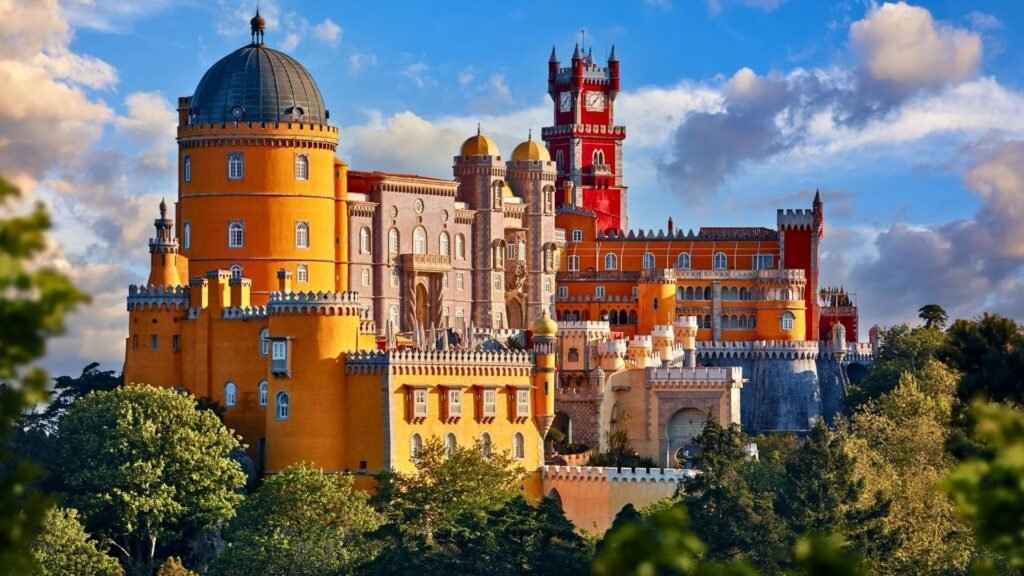
Europe’s castles are more than just pretty buildings; they are time capsules of ambition, conflict, and extravagance. Some are majestic, some are downright spooky, and all of them tell stories that are just as grand as their towering walls.
